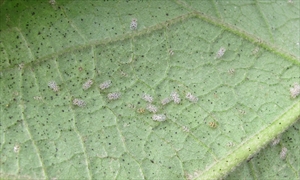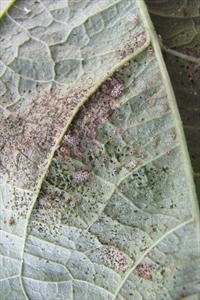Bean lace bug, cotton lace bug
Pacific Pests, Pathogens, Weeds & Pesticides - Online edition
Pacific Pests, Pathogens, Weeds & Pesticides
Bean lace bug (253)
Corythucha gossypii
North America (Hawaii, possibly Florida), and (restricted) Central and South America, and the Caribbean, Oceania. It is recorded from Fiji, American Samoa, Samoa.
Beans, bele, breadfruit, eggplant, Hibiscus, and many other hosts. CABI lists soursop and sweetpotato.
Nymphs and adults feed on the leaves sucking the sap with piercing mouthparts. In the process, brown faecal spots occur on the underside of the leaves (Photo 1), which also show white spots, large brown dead patches or yellow-white bleaching (Photo 2), depending on the host, and leaves may fall early.
The oval eggs are inserted into the underside of leaves in circular groups and covered in faecal matter. The nymphs are brown with black markings, and there are five stages (Photo 3). The adults are grey, about 3-4 mm long and 2 mm wide, with semi-transparent areas in the wings that give the 'lace-like' appearance (Photo 4). They have a plate-like structure behind the head which covers the thorax and comes to a point over the wings. These structures have short spines. The life cycle is complete in 3 weeks or less.
In tropical countries, during dry times, survival is likely to be as eggs, or perhaps as adults within leaf litter.
Usually, the damage is small, but when populations are high, in dry hot weather, the top surface of beans show stippling (small white marks) and large brown patches. Leaves of eggplant become bleached, turning a pale whitish yellow (Photo 2). The leaves may drop earlier than normal.
On eggplant, damage from above is similar to leaves infested by mites, but mite infestations invariably show webbing.
On bean, look for the dark brown patches on the underside of leaves (Photo 5), and speckling and large light brown patches above, that coincide with the damage underneath (Photo 6). On eggplant, look at the top surface of younger leaves for numerous small white flecks, and large patches of yellowish white on older leaves between veins that are still green. Look at the undersurface of the leaves for the grey lace bugs, about 3 mm long, and look for the brown dots of feacal matter on both hosts.
NATURAL ENEMIES
Lace bugs are usually kept under control by natural enemies of which there are several kinds. They include parasitic wasps, assassin bugs, lacewing larvae, ladybird beetles, pirate bugs, and more. To attract natural enemies, grow flowering plants nearby. And if applying pesticides, use those without long-term residual activity.
CULTURAL CONTROL
In general, ensure that the crop is healthy: provide adequate nutrients - manures or inorganic fertilizers - and preserve water with organic mulches. This will help plants tolerate the damage done by lace bugs, particularly in dry times.
CHEMICAL CONTROL
In most instances, populations of lace bugs will not be high enough to require the use of insecticides. If they are needed, use 'soft' options first, and if they do not provide adequate control test commercial products, contact or systemic insecticides. The soft options are:
Soap:
- Use soap (pure soap, not detergent).
- 5 tablespoons of soap in 4 litres water, OR
- 2 tablespoons of dish washing liquid in 4 litres water.
White oil:
- 3 tablespoons (1/3 cup) cooking oil in 4 litres water.
- ½ teaspoon detergent soap.
- Shake well and use.
Commercial products (e.g., horticultural oil) containing petroleum oil; follow the instructions on the product label. Make sure the oil can be used on the crops of interest, otherwise, it may damage the foliage.
These sprays work by blocking the breathing holes of insects causing suffocation and death. Spray the underside of leaves as the soaps and oils must contact the lace bugs. The sprays will need to be repeated after a few days, as the eggs may not be susceptible to "soft" insecticides.
Alternatively, use:
- Plant-derived products, such as neem, derris, pyrethrum and chilli (with the addition of soap).
- Note, a variety of Derris, brought many years ago to Solomon Islands from Papua New Guinea, is probably effective as a spray. It contains rotenone, an insecticide, so it should be used with caution. There may be varieties of Derris (fish poisons) in your country that can be tried (see Fact Sheet no. 56).
- Synthetic pyrethroids are likely to be effective against lace bug, but will kill natural enemies, too. Systemic insecticides such as acephate and imidacloprid, may also be effective when applied to the soil, but do not treat plants when they are flowering.
____________________
When using a pesticide, always wear protective clothing and follow the instructions on the product label, such as dosage, timing of application, and pre-harvest interval. Recommendations will vary with the crop and system of cultivation. Expert advice on the most appropriate pesticides to use should always be sought from local agricultural authorities.
AUTHOR Grahame Jackson
Information from Corythucha gossypii (2021). Wikipedia. (https://en.wikipedia.org/wiki/Corythucha_gossypii); and from Belov V (2019) BugGuide. (https://bugguide.net/node/view/1713682).
Produced with support from the Australian Centre for International Agricultural Research under project PC/2010/090: Strengthening integrated crop management research in the Pacific Islands in support of sustainable intensification of high-value crop production, implemented by the University of Queensland and the Secretariat of the Pacific Community. Photo 3 Mike Furlong, University of Queensland, Brisbane.










